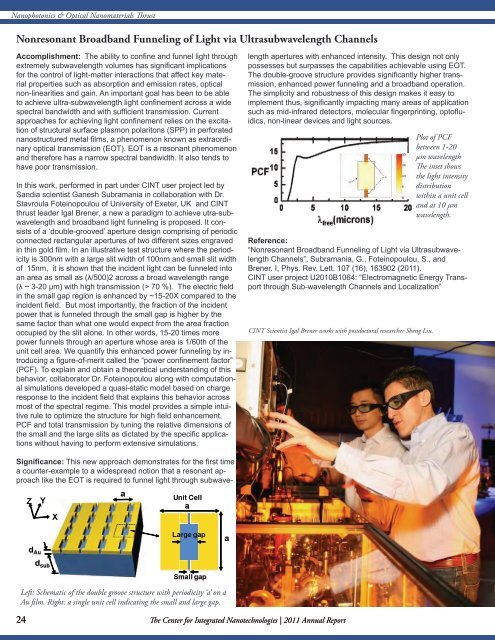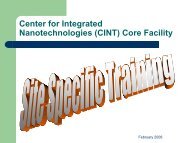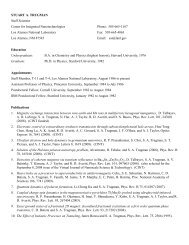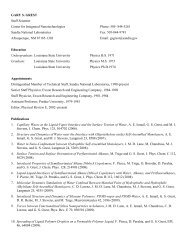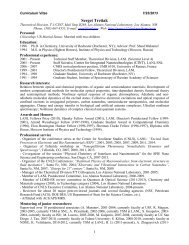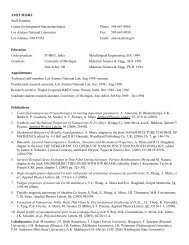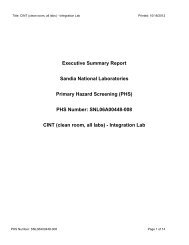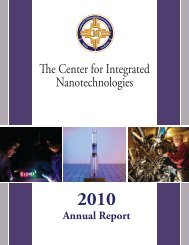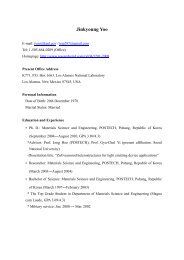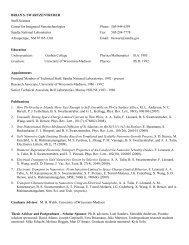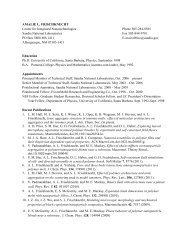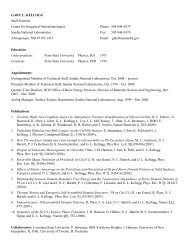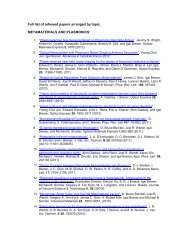2011 Annual Report - Center for Integrated Nanotechnologies - Los ...
2011 Annual Report - Center for Integrated Nanotechnologies - Los ...
2011 Annual Report - Center for Integrated Nanotechnologies - Los ...
Create successful ePaper yourself
Turn your PDF publications into a flip-book with our unique Google optimized e-Paper software.
Nanophotonics & Optical Nanomaterials Thrust<br />
Nonresonant Broadband Funneling of Light via Ultrasubwavelength Channels<br />
Accomplishment: The ability to confine and funnel light through<br />
extremely subwavelength volumes has significant implications<br />
<strong>for</strong> the control of light-matter interactions that affect key material<br />
properties such as absorption and emission rates, optical<br />
non-linearities and gain. An important goal has been to be able<br />
to achieve ultra-subwavelength light confinement across a wide<br />
spectral bandwidth and with sufficient transmission. Current<br />
approaches <strong>for</strong> achieving light confinement relies on the excitation<br />
of structural surface plasmon polaritons (SPP) in per<strong>for</strong>ated<br />
nanostructured metal films, a phenomenon known as extraordinary<br />
optical transmission (EOT). EOT is a resonant phenomenon<br />
and there<strong>for</strong>e has a narrow spectral bandwidth. It also tends to<br />
have poor transmission.<br />
In this work, per<strong>for</strong>med in part under CINT user project led by<br />
Sandia scientist Ganesh Subramania in collaboration with Dr.<br />
Stavroula Foteinopoulou of University of Exeter, UK and CINT<br />
thrust leader Igal Brener, a new a paradigm to achieve utra-subwavelength<br />
and broadband light funneling is proposed. It consists<br />
of a ‘double-grooved’ aperture design comprising of periodic<br />
connected rectangular apertures of two different sizes engraved<br />
in thin gold film. In an illustrative test structure where the periodicity<br />
is 300nm with a large slit width of 100nm and small slit width<br />
of 15nm, it is shown that the incident light can be funneled into<br />
an area as small as (λ/500)2 across a broad wavelength range<br />
(λ ~ 3-20 μm) with high transmission (> 70 %). The electric field<br />
in the small gap region is enhanced by ~15-20X compared to the<br />
incident field. But most importantly, the fraction of the incident<br />
power that is funneled through the small gap is higher by the<br />
same factor than what one would expect from the area fraction<br />
occupied by the slit alone. In other words, 15-20 times more<br />
power funnels through an aperture whose area is 1/60th of the<br />
unit cell area. We quantify this enhanced power funneling by introducing<br />
a figure-of-merit called the “power confinement factor”<br />
(PCF). To explain and obtain a theoretical understanding of this<br />
behavior, collaborator Dr. Foteinopoulou along with computational<br />
simulations developed a quasi-static model based on charge<br />
response to the incident field that explains this behavior across<br />
most of the spectral regime. This model provides a simple intuitive<br />
rule to optimize the structure <strong>for</strong> high field enhancement,<br />
PCF and total transmission by tuning the relative dimensions of<br />
the small and the large slits as dictated by the specific applications<br />
without having to per<strong>for</strong>m extensive simulations.<br />
Significance: This new approach demonstrates <strong>for</strong> the first time<br />
a counter-example to a widespread notion that a resonant approach<br />
like the EOT is required to funnel light through subwavelength<br />
apertures with enhanced intensity. This design not only<br />
possesses but surpasses the capabilities achievable using EOT.<br />
The double-groove structure provides significantly higher transmission,<br />
enhanced power funneling and a broadband operation.<br />
The simplicity and robustness of this design makes it easy to<br />
implement thus, significantly impacting many areas of application<br />
such as mid-infrared detectors, molecular fingerprinting, optofluidics,<br />
non-linear devices and light sources.<br />
Reference:<br />
“Nonresonant Broadband Funneling of Light via Ultrasubwavelength<br />
Channels”, Subramania, G., Foteinopoulou, S., and<br />
Brener. I, Phys. Rev. Lett. 107 (16), 163902 (<strong>2011</strong>).<br />
CINT user project U2010B1064: “Electromagnetic Energy Transport<br />
through Sub-wavelength Channels and Localization”<br />
CINT Scientist Igal Brener works with postdoctoral researcher Sheng Liu.<br />
Plot of PCF<br />
between 1-20<br />
μm wavelength<br />
The inset shows<br />
the light intensity<br />
distribution<br />
within a unit cell<br />
and at 10 μm<br />
wavelength.<br />
Left: Schematic of the double groove structure with periodicity ‘a’ on a<br />
Au film. Right: a single unit cell indicating the small and large gap.<br />
24<br />
24The <strong>Center</strong> <strong>for</strong> <strong>Integrated</strong> <strong>Nanotechnologies</strong> | <strong>2011</strong> <strong>Annual</strong> <strong>Report</strong>


